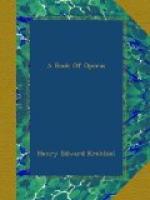since quit listening to it. But now my jaded faculties
were arrested by a new quality in the prelude.
I had always admired the composer of “Rigoletto,”
“Il Trovatore,” and “Traviata,”
and I loved and revered the author of “Aida,”
“Otello,” and “Falstaff.”
I had toddled along breathlessly in the trail made
by his seven-league boots during the last thirty-five
years of his career; but as I listened I found myself
wondering that I had not noticed before that his modernity
had begun before I had commenced to realize even what
maternity meant—more than half a century
ago, for “La Traviata” was composed in
1853. The quivering atmosphere of Violetta’s
sick-room seemed almost visible as the pathetic bit
of hymnlike music rose upward from the divided viols
of the orchestra like a cloud of incense which gathered
itself together and floated along with the pathetic
song of the solo violin. The work of palliating
the character of the courtesan had begun, and on it
went with each recurrence of the sad, sweet phrase
as it punctuated the conversation between Violetta
and her maid, until memory of her moral grossness
was swallowed up in pity for her suffering. Conventional
song-forms returned when poet and composer gave voice
to the dying woman’s lament for the happiness
that was past and her agony of fear when she felt
the touch of Death’s icy hand; but where is
melody more truthfully eloquent than in “Addio,
del passato,” and “Gran Dio! morir so
giovane”? Is it within the power of instruments,
no matter how great their number, or harmony with all
the poignancy which it has acquired through the ingenious
use of dissonance, or of broken phrase floating on
an instrumental flood, to be more dramatically expressive
than are these songs? Yet they are, in a way,
uncompromisingly formal, architectural, strophic, and
conventionally Verdian in their repetition of rhythmical
motives and their melodic formularies. This introduction
to the third act recalls the introduction to the first,
which also begins with the hymnlike phrase, and sets
the key-note of pathos which is sounded at every dramatic
climax, though pages of hurdy-gurdy tune and unmeaning
music intervene. Recall “Ah, fors’
e lui che l’anima,” with its passionate
second section, “A quell’ amor,”
and that most moving song of resignation, “Dite
all’ giovine.” These things outweigh
a thousand times the glittering tinsel of the opera
and give “Traviata” a merited place, not
only beside the later creations of the composer, but
among those latter-day works which we call lyric dramas
to distinguish them from those which we still call
operas, with commiserating emphasis on the word.




